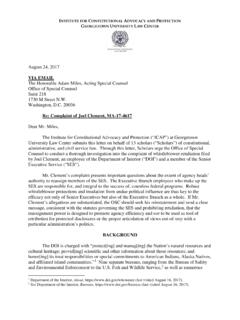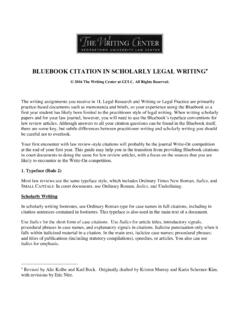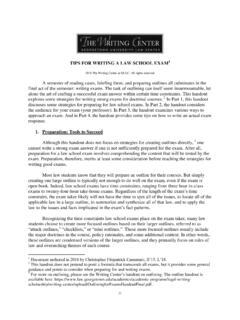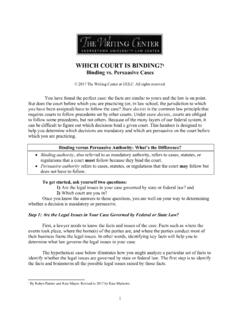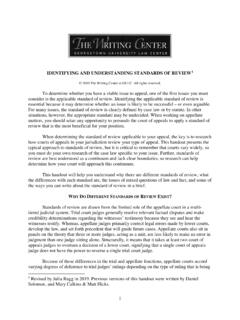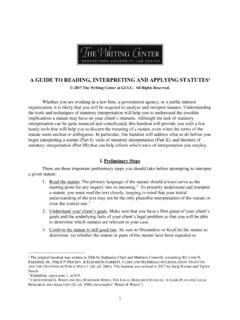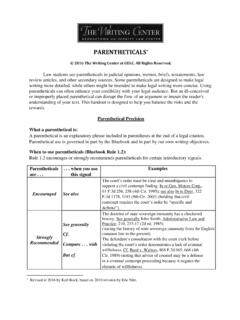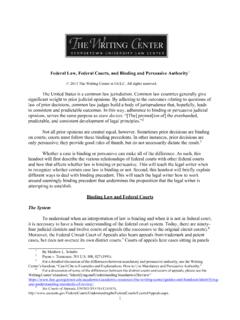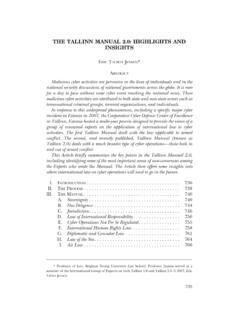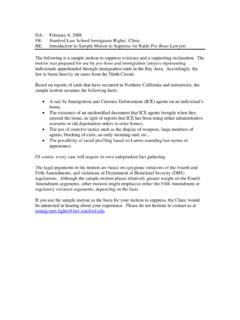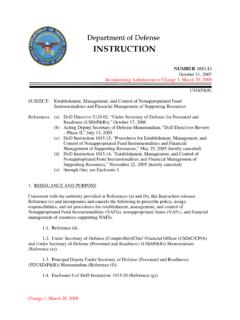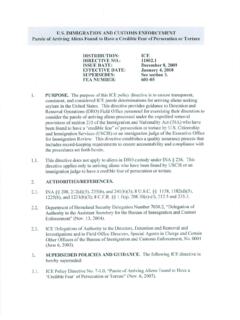Transcription of The Bench Memorandum - Georgetown Law
1 1 The Bench Memorandum By Jessica Klarfeld 2011 The Writing Center at GULC. All rights reserved. The Bench Memorandum is a document written by a law clerk for an appellate judge, which the judge uses in preparing for oral arguments. A trial judge may ask his clerk to write a Bench memo in advance of a motions hearing; however, writing Bench memos at the trial court level is less common. Some of the Georgetown Legal Research and Writing faculty require law fellows to write Bench memos on the same topic on which their first-year students write their briefs.
2 When first-year students have oral arguments on their briefs, the student judges will use the law fellows Bench memos to familiarize themselves with the parties arguments. The Bench memo itself does NOT decide the case; it is not a brief by counsel or a judicial opinion. Rather, the Bench memo simply advises a judge by offering an objective review of both sides of the case. As opposed to a brief, which explores only one side s arguments (with brief discussion of counterarguments), the Bench memo summarizes and develops both sides arguments, recognizes the merits and drawbacks of those arguments, and recommends a course of When writing a Bench memo, it is important to remember to focus on the best interests of justice.
3 The Bench memo must help judges get past the advocacy of the parties briefs so that they can reach independent 1 See MARY DUNNEWOLD, BETH A. HONETSCHLAGER & BRENDA L. TOFTE, JUDICIAL CLERKSHIPS: A PRACTICAL GUIDE 126 (2010). 2 Id. (noting that the Bench memo must clearly and accurately describe the facts of the case, the procedural posture, the applicable law, the parties arguments, and the clerk s independent analysis of the issue). 2 HOW Bench MEMOS COMPARE TO MEMOS AND BRIEFS3 MEMO Bench MEMO BRIEF PURPOSE Memos discuss, recommend, and advise.
4 The memo objectively informs a reader about what the law is. It illustrates what the outcome will likely be when the law is applied to a particular set of facts. Bench memos discuss, recommend, and advise. The Bench memo objectively informs the reader what the law is and what the parties arguments are. It illustrates what the outcome should be when the law is applied to the facts of the case. Briefs argue. The brief seeks to persuade the reader that your application of your law to the facts is the correct one. The goal is to win the case, using the law in the most favorable way to your client.
5 AUDIENCE Another lawyer, supervising attorney, client. Appellate judge, district judge, judicial clerk. Opposing lawyer, appellate judge, judicial clerk, client. STANCE Objectivity in research is necessary when writing a memo. A memo writer can then use the outcome of that research to present his client s case most favorably. A memo writer, however, is clear about the strengths and weaknesses of his client s case. Objectivity in research is necessary when writing a Bench memo. A Bench memo writer can use the outcome of that research to determine which party s arguments are stronger.
6 A Bench memo writer is clear about the strengths and weaknesses of each party s case. Objectivity in research is necessary when writing a brief. A brief writer strives to use that research to create legal arguments and offer legal conclusions that cast his client s case favorably. A brief writer emphasizes the strengths, while minimizing the weaknesses, of his client s case. LENGTH OF A Bench MEMO Unfortunately, there is no magic number of pages that your Bench memo should be. The length of a Bench memo can greatly vary. Some Bench memos are single issue memos, in which a judge may request that you write a short memo on an individual issue that attorneys have not explained adequately.
7 This single issue memo may be as short as two or three pages. More typically, though, as a judicial clerk or law fellow, you will write longer full-case memos, which could even be fifty pages if there are comprehensive facts and multiple issues that the court needs to decide. 3 See The Writing Center, Georgetown University Law Center, From Memo to Brief (2004) (comparing memos and briefs). 3 AUDIENCE OF A Bench MEMO The process of writing a Bench memo is fairly uniform among courts; however, it is important that you clarify the expectations of your judge (or professor, if writing the Bench memo as a law fellow) before starting to write.
8 Knowing your audience is the first step in successful Bench memo writing, and you must always do as the judge Also, while stylistic and structural preferences of the judge are important, knowing your audience also requires knowing to what use your judge will put your Some judges use the Bench memo early in the process to help them develop an overall picture of the case; others read the Bench memo last, once the facts and arguments are clear in their It is also important to note that in appellate courts, the Bench memo will likely be read by every member of the panel (typically three judges in intermediate appellate courts and the full court in state supreme courts), not just the clerk s own STRUCTURE OF A Bench MEMO FOR AN APPELLATE COURT A standard, full-case Bench memo for an appellate court usually consists of the following parts.
9 (I) Issues on Appeal, (II) Procedural Posture, (III) Statement of Facts, (IV) Standard of Review, (V) Analysis, and (VI) Recommendations. I. Issues on Appeal The issues should be framed such that the judge understands exactly what needs to be decided. An effective issue statement includes: (1) A reference to the relevant law (2) The legal question (3) Any legally significant facts In mentioning the legally significant facts, it is important that you maintain objectivity, addressing facts that are favorable to one side (and thus unfavorable to the other) and vice versa.
10 The issues on appeal are often framed in terms of whether the district court ( , trial court) correctly/incorrectly (properly/improperly, etc.) did x. In framing it as correctly, one could assume that the result you ultimately will reach is that whatever the district court did was proper. Similarly, in framing it as incorrectly, one could assume that the result you ultimately will reach is that whatever the district court did was improper. This is a safe assumption, and given that you ultimately will provide a recommendation in the Bench memo, it is appropriate to frame the issues as such.
